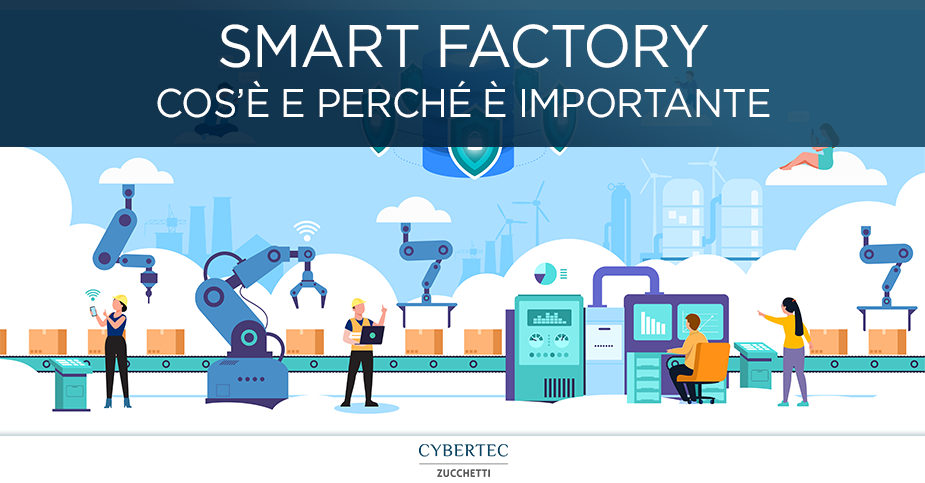The progressive spread of new technologies that are radically modifying factories is the direct consequence of the fourth industrial revolution, the so-called Industry 4.0. Smart Factories are highly digitized and take advantage of IoT technology and Big Data to respond to the need for agility of companies operating in increasingly variable contexts. Among the advantages and obstacles that in part still limit its more radical spread, Smart Factories are poised to be the factories of the future.
Whatis a Smart Factory
The Smart Factory is a digitalized and connected factory, with plants composed of robotic machines capable of making decisions autonomously and of self-correcting thanks to the interaction with the surrounding environment. It was born from the fourth industrial revolution, or Industry 4.0, characterized by the transition to the digitization of production, which exploits Information Technology (hardware and software for information management) and Operational Technology (control and automation actions at the base of operations).
The key features are visibility, connectivity and autonomy, as they are able to operate without human intervention and to learn and adapt almost in real time. Routine tasks are in fact managed by an AI and people focus on managing exceptions or decisions at higher levels.
The Smart Factory is the type of factory that adapts to the highly variable context in which more and more companies operate, marked by customized products and individualized services that require extremely reactive industries. The Smart Factory therefore responds to the needs of a company that aspires to be agile and able to easily adapt production to the changing needs of the context, where digital intelligence is applied to research and product innovation.
The elements of the Smart Factory
Smart Factories optimally apply Industry 4.0 technologies to keep all business processes under control and collect data to be used in multiple ways. In a fully connected Smart Factory, each facility is connected to the others and the entire company is connected internally between departments and externally with customers and suppliers. It is based in particular on:
- IoT objects: devices, machines and processes that are always connected to collect and facilitate the exchange and use of data between people and machines.
They drive operational efficiency, control and visibility on actionable key metrics. - IoT sensors: they are connected to devices and machines and allow data to be collected at different stages of the production process, giving visibility into multiple conditions. The data can be used by AI to make self-correcting actions or by review team members.
- Cloud Computing: to store, process and share data quickly and flexibly.
- Big Data: the collection of very large amounts of data allows us to have valuable information on the efficiency of the production process, on key metrics and can help detect errors through predictive controls.
The advantages of the Smart Factory
The advantages of the Smart Factory are related to having access to large amounts of data, which provide real-time information to be used in decision-making processes. In general, they can be summarized in the following benefits:
- More linear process: the optimization of data and process management and the more efficient use of resources leads to an overall reduction in costs, in particular those of order management, material handling and inventory maintenance.
- Maximum flexibility: guaranteed by the fact that the Smart Factory is designed to adapt to different production environments and production configurations.
- More agility: in responding to fluctuations in production demand
- Improved predictability: Continuous big data analysis and monitoring of industrial operations provides greater visibility into the supply chain.
- Verified Productivity: Production machines are used to receive orders, report progress, access work instructions, and interact with quality and traceability systems. This makes it easier for plant workers to see important information such as instructions, schedules, quality data, inventory status, and changes in demand.
The challenges of the Smart Factory
However, there are some obstacles that currently tend to limit the widespread adoption of Smart Factories.
A first problem is related to data integration. To manage huge amounts of data from different components, in different sectors and formats, you need specific analytical tools. In addition, to introduce machinery compatible with this technology, it is necessary to first proceed with the dismantling or updating of old equipment, a process that is not always immediate and challenging from a cost point of view.
Another critical issue is the security risk deriving from the presence of many interconnected instruments. Attacks aimed at compromising production or creating malfunctions in processes could exploit the various points of entry into the system, such as the connection between the shared computer connected to the plant and the rest of the system, or the connection between the smart production system and the software libraries.
An example of a Smart Factory
An example of an Italian Smart Factory is that of Morato Pane, a company that operates in the industrial baking sector and has grown to become the second group in Italy. It is a very innovative company compared to the food industry standard, which, driven by ambition and the desire for improvement, has implemented advanced solutions for production planning and scheduling.
The use of an APS has made it possible to manage all the critical issues typical of the sector, such as the use of perishable raw materials, the seasonality of products, the presence of promotional peaks and production planning for private labels. The new technology introduced allows you to have visibility on the lines and to quickly process large amounts of data, reducing planning times.
Smart Factory management software
To make the most of the competitive advantage offered by this type of technology, it is important to choose the right DDMRP software. APS CyberPlan responds to these needs because it integrates seamlessly with management systems (such as Zucchetti, Oracle, SAP, etc.) and exchanges accurate, timely and up-to-date data with them. Contact a supply chain and smart factory expert, ready to answer your questions and support your growth.

